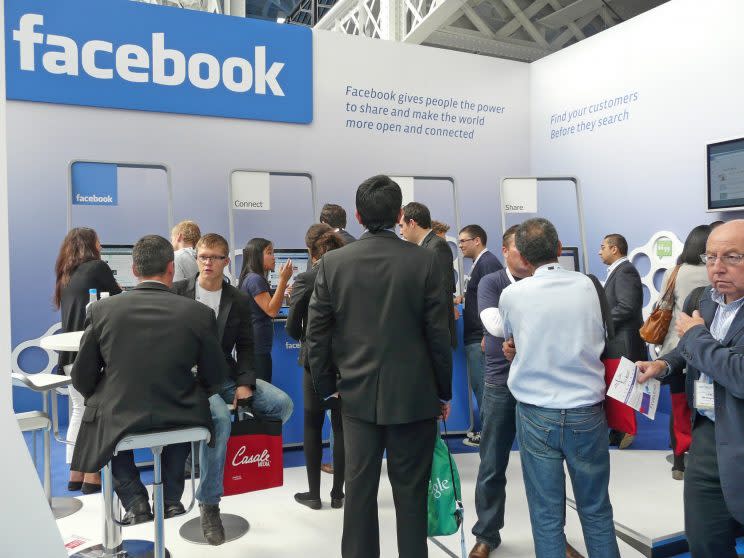Facebook outlines its plan to insert ads into Live videos

DENVER — Facebook knows you like live video — and it’s pretty sure that you won’t mind if those real-time clips start playing automatically with audio, then have ads appear in the middle.
Facebook product director Fidji Simo revealed the new details about the social network’s video strategy during in an interview with CNN’s social-news director Samantha Barry here at the Online News Association’s conference. Barry was less successful in getting Simo to explain the complex relationship status between Facebook (FB) and news organizations.
What’s next for Live
Live — a product that Facebook launched only last August as a celebrities-only feature, but which now stands as a key part of its strategy — took up much of Simo’s time.
Facebook takes Live seriously enough to pay some sites and social-media stars to stream Live video. But it also stumbled badly when it took down the video of Philando Castile’s death after he was shot by a police officer.
Simo said Facebook has to decide if videos of violence glorify it or report it. If the video is reporting on violence, Facebook will keep the clip but add a warning, disable it from playing automatically and hide it from users under 18.
Simo added that the company has teams of people working worldwide around the clock to police videos.
When asked by Barry if the News Feed will become all video — something a Facebook executive said could happen within five years — Simo said it won’t be entirely video, but will definitely feature a lot more, much of it 360-degree, virtual-reality clips.
“You want to feel like you are part of the action,” she said.
At some point, you may be able to watch Facebook video on a media player like a Roku, depending on how many people take advantage of a new option to cast it to an Apple TV or a Chromecast.
Facebook is also considering two changes that may not earn many Likes. One is inserting “mid-roll” ads into video streams, which Facebook plans to bring to Live this year and may add to non-Live videos later on. “People really understand the concept,” she said.
The other is having video play automatically with the sound on — today, it autoplays silently. As a result, only 50% of the time spent watching video on Facebook involves audio.
Simo said the company is running a test to turn sound on by default in News Feed. “We think that actually could be a much better experience.”
(Yes, I’m aware that Yahoo Finance stories sometimes feature videos that automatically play with the sound on.)
Simo also offered two tips about using Live well: Offer some suspense (she cited police chases and stormy weather but somehow did not mention BuzzFeed exploding a watermelon by tying rubber bands around it), and have the stream run at least 10 minutes to give your audience time to find it.
Worries over the Trending list
Simo was at her least helpful when Barry asked if Facebook has become a media company, something founder Mark Zuckerberg recently denied. She repeated that denial, explaining that Facebook doesn’t create content of its own.
But after saying that “we play a big role in the media industry, and we take that responsibility very seriously,” she touched on the various ways Facebook does not let the News Feed run itself.
Facebook has repeatedly changed the algorithms that determine what shows up in each person’s Feed to try to address what its users want — and to make life harder for clickbait and falsehoods.
“We care a lot about making sure that what’s shared on Facebook is authentic,” she said.
We have a word in journalism for that sort of involved attention to what a reader sees: editing.
Barry quizzed Simo at length about the part of the News Feed that looks most like a news site: Facebook’s list of trending stories. It’s been in the news itself lately, and not in good ways. First, conservative critics accused Facebook of burying stories hostile to Democrats, then Trending publicized a few phony stories.
“We do not want any fake news trending,” Simo said. “We know we’re not where we want to be.”
But this isn’t a problem Facebook plans to solve by hiring more people, she added — that would be too hard for a product that must work worldwide (Yes, that’s the opposite of what Simo said about policing Live videos.) Instead, the company is betting on smarter algorithms and better tools for users to flag fake stories.
Questions unanswered
Journalists are nervous in general about Facebook because the social network has become such a massive distribution mechanism. A survey released in May by the Pew Research Center found that 66 percent of US Facebook users get news from the site.
But Facebook consistently keeps many of its own workings obscure. News organizations know they need to connect with their audiences, but then struggle to figure out why some of their work reaches so few people.
Facebook is aware of this but consistently shies away from providing clearer answers. It’s become an unfortunate ONA tradition for Facebook reps to show up at this conference and respond to questions about things like the News Feed algorithm with a version of “you should create really compelling content.”
The ONA site invited attendees to submit questions in advance. Sadly, this one wasn’t asked of Simo: “We want to fully embrace Facebook, but we’re weary of you changing the rules with little notice or transparency. Can we trust Facebook?”
More from Rob:
Congress could blow an opportunity to fix a major email privacy issue
T-Mobile and Sprint’s new unlimited plans aren’t exactly unlimited
We need more high-speed internet, but politicians are blocking the way
Email Rob at [email protected]; follow him on Twitter at @robpegoraro.
